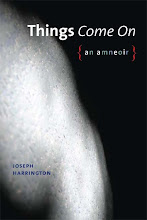I applied for a fellowship to work on a series of books I’m doing about my mother’s life and times (the first of which, Things Come On, is scheduled to be “out” next month). I was told that I didn’t get it because I hadn’t provided adequate reasons for my writing in multiple genres (verse, prose, dramatic dialogue) within a single book. I thought I'd addressed that issue – but then I’m not the one handing out the fellowships.
So I started thinking more systematically about it. The most obvious and general reason is that I’m a believer in trying not to separate form and content – i.e., that it’s a false dichotomy. So, rather than trying to make a welter of heterogeneous materials fit into a pre-determined form (e.g., the linear narrative of standard prose autobiography – or Spencerian stanzas – or five acts), I am attempting to let the materials of the books – diaries, scrapbooks, conversations, photographs, hand-written documents, letters, etc. – and combinations of materials from a given time period – suggest the shape of the text into which I am integrating them. As the nature or tone of the materials change, so does that of the narrative, and therefore, its shape.
The bigger issue here, one which I’ve addressed before, is the generality/particularity or deductive/inductive issue. Writing a biography of any kind (maybe a non-fiction book of any kind – maybe a book of any kind) is the experience of being confronted with lots of materials, voices, ideas. The author must somehow select from amongst that mass of Stuff and compose the selected materials, along with his or her own words, in such a way that the reader gets, at the very least, patterns of images, themes, feelings, that add up to something more than any single one (whether or not that something is "greater than the sum of the parts" – the assumption behind that expression is precisely the problem, seems to me).
One way to go about that, of course, is to select for a certain type of story, or a certain genre of story, and then to force any recalcitrant materials to conform to that type. The default type is the absorptive “page-turner” that sews everything together into one central storyline – like a realist novel, whether or not the nonfiction book includes dialogue, point-of-view, composite characters, etc.
But to my mind, part of the thing that makes life stories interesting is precisely that welter of particulars – either because I recognize some of the places and personality types instantly (e.g., Memphis Afternoons, by James Conaway) or because I’m confronted with a set of people and details that are radically different from those in my own life (e.g., The Immortal Life of Henrietta Lacks, by Rebecca Skloot). The Skloot book, for instance, makes no bones about switching from a journalistic to novelistic to memoiristic telling of events, as the events themselves seem to demand it. And I think one reason is that she took seriously this question of fitting the structure of the narrative to the narrative that needed telling - in part as a way to try to honor the particularity of the lives she is writing about (including her own).
So, the multi-genre non-fiction book is less like a novel than a scrapbook – that hybrid, connect-the-dots story book formed by the relations between its elements – which are very diverse elements indeed. As Susan Howe puts it, “The relational space is the thing that’s alive with something from somewhere else.”
Now to try to condense all this into a single paragraph for the application!
Tomorrow (well, OK – soon, anyway): Multi-genre writing and the elegiac mode.
"You only give me your funny papers"
-
The man in his 60s had been talking to people at the United gate; he was
clearly a man who liked to converse. We sat next to each other in row 28. A
v...
6 days ago











No comments:
Post a Comment